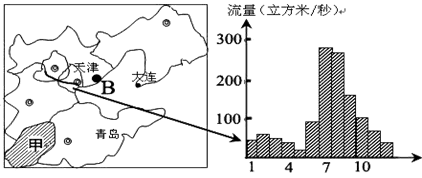读图回答下列问题。(12分)

⑴ 简述图示河流最小流量出现的时间及其原因。(4分)
⑵ 说出甲基地最主要的商品性农作物,分析该基地形成与发展的优势条件(5分)
农作物 、
⑶ 近年来外资企业纷纷落户天津、青岛、大连,其共同的区位优势有哪些?(3分)
⑴ 春季(3-5月)(1分) 春末夏初,雨季尚未到达,降水稀少,补给少;气温回升快,蒸发旺盛;农业用水量大(3分)
⑵ 棉花(1分) 地形平坦、土层深厚、土壤肥沃;夏季雨热同期,降水较多,有利于棉花的生长、秋季雨水少,有利于棉花的后期生长和收摘;劳动力丰富,植棉历史悠久;交通便利;市场广阔(棉纺织工业基础好)(任写4个给4分)
⑶ 沿海港口城市,交通便利,信息畅达;劳动力丰富且素质较高,高等院校众多;临近日韩,便于承接产业转移;工业基础、协作条件较好(任写3个给3分)
本题考查我国华北地区。
(1)结合图示海陆轮廓判断该地区表示华北地区,图示河流为海河,受华北地区春旱影响,河流流量最小为春季,从降水量、蒸发量和用水量等方面分析。
(2)甲表示冀东南、鲁西北、豫北平原,为我国著名的商品棉基地,该基地发展棉花种植的优势条件从气候、地形、土壤、水源等自然条件和交通、市场、科技、政策、劳动力、农业基础等社会经济因素分析。
(3)该地区经济发展的优势条件从自然条件:地理位置、土地、水源和社会经济因素:市场、交通、科技、政策、劳动力、工农业基础等方面分析。
